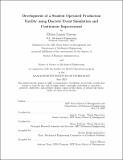| dc.contributor.advisor | Anthony, Brian | |
| dc.contributor.advisor | Carrier, John F. | |
| dc.contributor.author | Greene, Ethan Logan | |
| dc.date.accessioned | 2024-04-17T21:11:03Z | |
| dc.date.available | 2024-04-17T21:11:03Z | |
| dc.date.issued | 2023-06 | |
| dc.date.submitted | 2023-08-08T19:01:42.600Z | |
| dc.identifier.uri | https://hdl.handle.net/1721.1/154199 | |
| dc.description.abstract | The Device Realization Laboratory at MIT is committed to developing accessible, affordable devices for hands-on learning experiences in smart manufacturing. The laboratory’s main method is the desktop fiber extrusion device, FrED, produced in the student-operated and -managed FrED Factory. This paper chronicles an intensive eight-month project directed toward enhancing the efficiency and throughput of the
FrED Factory.
The project began with a systematic analysis of the intricacies of the fiber extrusion device, the factory, and the associated manufacturing processes. A key component of the project was the development of a digital twin, leveraging discrete event simulation to amplify the modeling and analytic capabilities of the student operators.
A comprehensive characterization of the initial state of operations was conducted, revealing the existence of hidden factories and various types of waste. Strategic, iterative solutions were then formulated and implemented, driving significant improvements over time. The project incorporated 5S methodologies, laying the groundwork for a continuous improvement program, and executed a Kaizen event focusing on the underutilized 3D printing farm that was plagued with printing failures.
Key results from the Kaizen event included reducing print cycle times, improving printer utilization, reducing print failure rates, and boosting the 3D printer farm throughput. The project achieved a substantial reduction in calibration frequency and part defects through a dual approach: minimizing vibration and storage rack swaying issues, and decreasing bed-leveling variation with the print beds, thereby further enhancing utilization. However, the most significant outcome was realized through the alleviation of manufacturing constraints on printer configurations, which led to a 4.2x improvement in the theoretical throughput of the 3D printers.
The project’s journey and results offer invaluable insights and a replicable model for future implementation of student ran production facilities in other university laboratories, highlighting the importance of continuous improvement and the power of advanced technology in accelerating development and operational efficiency. | |
| dc.publisher | Massachusetts Institute of Technology | |
| dc.rights | In Copyright - Educational Use Permitted | |
| dc.rights | Copyright retained by author(s) | |
| dc.rights.uri | https://rightsstatements.org/page/InC-EDU/1.0/ | |
| dc.title | Development of a Student Operated Production Facility using Discrete Event Simulation and Continuous Improvement | |
| dc.type | Thesis | |
| dc.description.degree | M.B.A. | |
| dc.description.degree | S.M. | |
| dc.contributor.department | Massachusetts Institute of Technology. Department of Mechanical Engineering | |
| dc.contributor.department | Sloan School of Management | |
| dc.identifier.orcid | https://orcid.org/0000-0002-5483-5391 | |
| mit.thesis.degree | Master | |
| thesis.degree.name | Master of Business Administration | |
| thesis.degree.name | Master of Science in Mechanical Engineering | |
